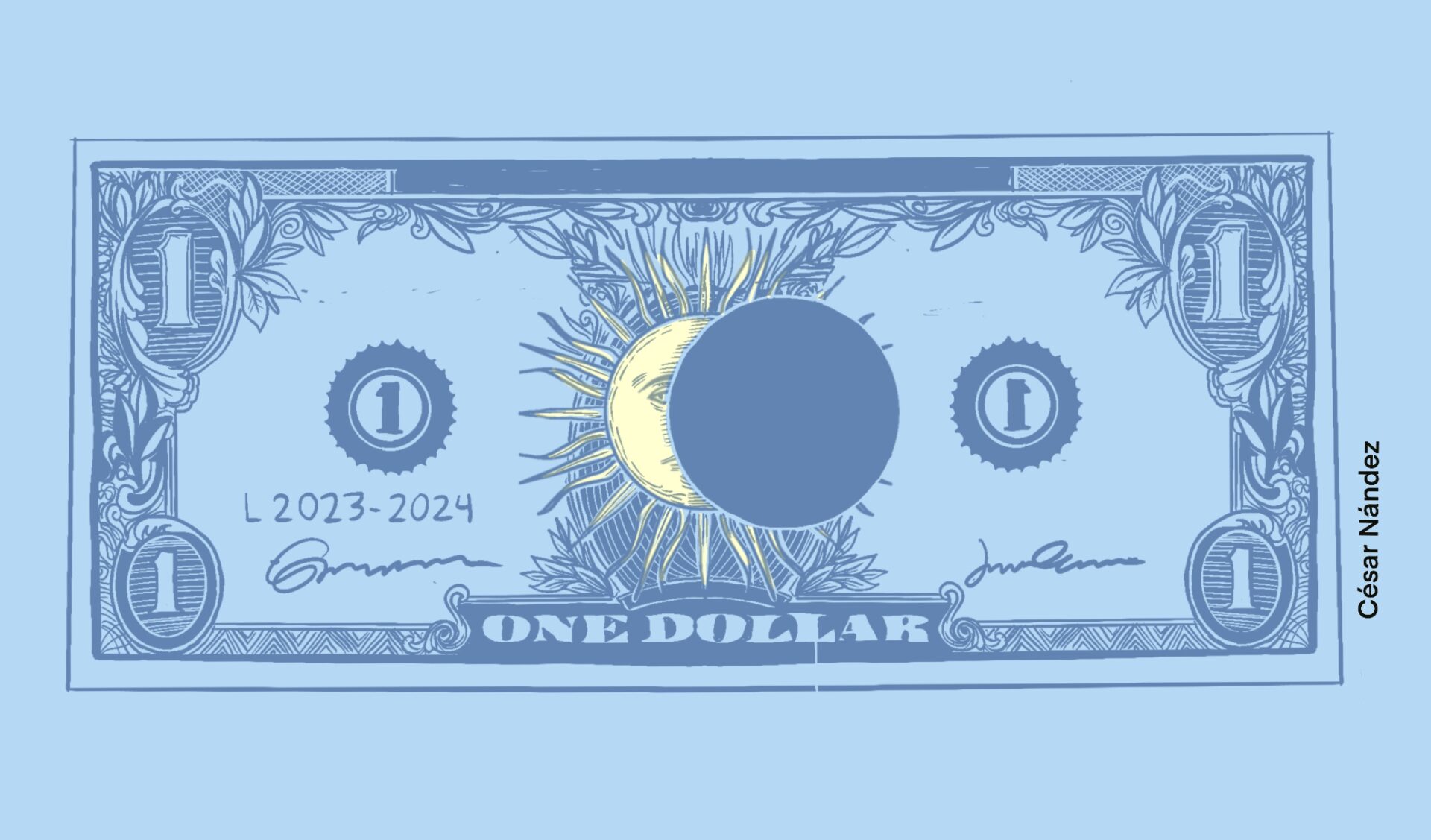Dollarization was at the core of Javier Milei’s campaign. And, undoubtedly, one of those pragmatic and no half-measures proposals that most resonated with the Argentine electorate. In contrast, for example, with the more gradual styles of Macri and Bullrich. With year-on-year inflation of 148% in November according to the National Institute of Statistics — INDEC (only surpassed by Lebanon and Venezuela), it is not surprising that the idea of banishing inflation “the hard way”, even if it leaves dead and wounded along the way, connects powerfully with the population at this time. However, the truth is that the side effects of dollarization are too important to ignore and the costs involved may be overwhelming concerning the benefits.
But we shall nuance the matter (with the mechanics’ pardon): Dollarizing the Argentine economy is like putting Caterpillar tractor tires on a Volkswagen Beetle. If we consider inflation to be the potholes of a very poorly maintained road, the huge tires installed on the small vehicle (assuming such an installation is possible) will allow it to overcome these obstacles without difficulty. However, the enthusiastic driver, although satisfied to have overcome the discomforts of inflation, will hardly be able to maneuver freely around the sharpest curves and, in general, in the face of any situation requiring agile handling.
For example, if the ominous black cloud of an international crisis is looming on the horizon, a sensible driver will probably decide to pull off the road he is on to take a detour that will take him away from the storm or at least allow him enough time to prepare before its inevitable arrival. Maneuverability becomes of paramount importance in this context.
This is precisely what a responsible Central Bank does when faced with external shocks that may: a) reduce economic growth below its potential, or b) push inflation above target levels (usually between 2% and 4%). With that in mind, if Argentina officially uses the U.S. dollar and does not have its own currency, although it will certainly solve the problem of the uncontrolled inflation it suffers today, will lose the ability to make the necessary economic policy maneuvers to soften the adverse effects on the economy.
That is to say, like our heroic driver who suffers to maneuver this almost mythological fireball we have invented (half beetle, half tractor), dollarizing the Argentine economy, while offering a direct solution to one of the most pressing problems for ordinary citizens, puts a straitjacket on the country’s economic policy that severely limits its ability to respond to the economic storms that will inevitably fall along the way. This can create longer-term problems with more complicated effects to reverse, such as chronic low potential growth, low productivity, and perpetually high levels of poverty, to name a few.
But let’s be more specific: What are these deterrent maneuvers that a central bank can perform and that would be lost if Milei opts for a change in the tires of dollarization? Let us focus on the two most important ones: 1) The adjustment of the reference interest rate, and 2) the ability to devalue the currency.
The reference rate is a monetary policy instrument that seeks to influence short-term (and eventually long-term) market rates in the direction that the Central Bank requires easing or tightening financial conditions and, thus, accelerate or cool the economy, depending on the priority of the moment (usually low growth or high inflation, although recently this dichotomy has taken on more complicated nuances). This ability to smooth economic cycles is key for any country because it cushions the harmful effects of inflation and low growth on the most vulnerable. With dollarization, Argentina would lose this capacity (along with other monetary policy tools).
The other fundamental element that a Central Bank has to face external shocks is the ability to devalue its currency. Let us explain this by temporarily abstracting from the exchange controls that currently exist in Argentina: In an economy with a flexible exchange rate, the value of the currency fluctuates in response to the balance between supply and demand for that currency. This balance is strongly associated with the country’s trade balance. If there is a trade surplus (the country exports more than it imports), there will be upward pressure on the demand for its currency and on its value because a higher amount of foreign currency (let us say dollars) will come in from exports, compared to the amount of dollars leaving the economy to pay for imports. In this situation, the dollars will be converted by exporters into local currency (say pesos) to pay payrolls, taxes, etc., pushing its value upwards. In other words, in very simplified terms, an economy that exports more than it imports sees its currency appreciate and vice versa.
However, what would happen, for example, if in the face of a new scientific discovery about the effects of soy on people’s health, the demand for this important Argentine export product falls sharply? In such a situation, Argentina will need to become more competitive internationally to counteract part of the effect of this drop in soybean demand. This would imply lowering the prices of soybeans and its other export products relative to its main competitors. The automatic mechanism through which a flexible exchange rate would “help” Argentina to face this shock and make its products cheaper abroad follows this sequence: 1) the negative shock to international demand for soybeans reduces Argentine exports of this product, 2) lower exports generate lower inflow (supply) of dollars into the Argentine economy and lower demand for pesos, 3) the peso devalues due to this, 4) the peso devaluation implies that Argentine products (at the same prices in pesos as before) are now cheaper (in dollars) and are in a better competitive position compared with competing countries. Finally, 5) this allows recovering, to a certain extent, the country’s export level before the external shock. In other words, the exchange rate automatically adjusts to rebalance (in part) the imbalance in the trade balance generated by the external shock.
In a dollarized economy, since there is no longer a currency that can be devalued, this automatic stabilization mechanism ceases to work and the adjustment to external shocks can come, rather, through a sharp fall in prices and wages (deflation).
This deflationary adjustment to external shocks leads to periods of weak growth, which, incidentally, explains much of the recent economic history of Ecuador, a country that is constantly referred to as an example of successful dollarization, having ended inflation (an almost automatic effect of dollarization), but which has been growing, according to the World Bank, at an average rate of 2.87% during the past 20 years, a level much lower than it should have experienced given its level of development and the commodity price super cycles that have occurred during that period.
So, there goes our little Beetle, looking strange with those tires that are not made to fit it and that prevent it from making the dissuasive maneuvers it needs to face the risks that are coming down the road. Beyond whether the installation of dollarization tires is feasible (will it be possible to obtain enough dollars to make the conversion?), it is clear that much more is lost than gained with these measures.
What is the alternative, then? The first matter is to recognize that no solution is simple and all of them carry high costs. With that in mind, few economists will disagree that the first best scenario is one in which Argentina maintains its own currency and, thus, does not lose its monetary policy, the ability to carry out competitive devaluations, or its role as lender of last resort (also a fundamental point, yet not developed in this article).
Nonetheless, the crux of the matter lies in the political consensus Javier Milei achieves to implement the necessary reforms to achieve this first best, which means repairing the economic highway instead of putting the wrong tires on the car he will be driving for the next 4 years. Repairing the roads implies a drastic fiscal consolidation program to close the deficit and with it the need to abuse the infamous “maquinita” (printing pesos to finance it) which is the almost exclusive source of the explosive increase in inflation in Argentina. And for proof, a button (or two): Chile and Peru did it in the 1980s and 1990s. The adjustment was harsh, but both countries managed to emerge from the crisis, eliminate price controls, and maintain decades of low inflation and macroeconomic stability.
Nevertheless, the examples of these two countries also show that more is needed to plug holes and pave the road. The rules of the road must be clear and must be enforceable. “Dangerous Curve” and “Slow Down” are signposts that every road in a serious country must have and that the economy must replicate in the form of, for example, fiscal rules with clear limits, central bank independence, and constitutional provisions prohibiting price controls and the use of subsidies as political weapons. This implies that structural reforms should be accompanied by thorough constitutional reform.
Finally, declaring myself a staunch fan of analogies based on professions of which I know absolutely nothing, here is one more (this time with the pardon of firefighters): the dollarization of the Argentine economy is like trying to put out a candle with a fire extinguisher. While it succeeds in extinguishing the dangerous flame of inflation, it also suffocates all the other flames that are vital for a healthy economy, such as the ability to affect financial conditions through the reference rate, the possibility of devaluing one’s own currency, and the crucial role of the Central Bank as lender of last resort. The result is to leave economic policy in uncomfortable obscurity, depriving it of many necessary tools to cope with the economic storms ahead. I leave it to you to judge whether dollarization is more like maneuvering a Volkswagen Beetle with Monster Truck aspirations or groping along a bumpy road.
*Translated by Janaína Ruviaro da Silva from the original in Spanish













